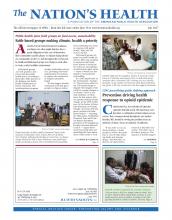In 2014, about 27,000 older Americans died as the result of a fall. The number means falling — which makes up $31 billion in U.S. medical costs every year — is the leading cause of fatal and nonfatal injuries among Americans 65 and older. And that number is expected to grow.
“Fall prevention is vitally important,” said Kathleen Cameron, MPH, senior director for the Center for Healthy Aging at the National Council on Aging. “We’re seeing increasing numbers of adults falling every year and that’s expected to continue due to the aging of the country. In fact, fall prevention should be an integral part of health care and social services for older adults.”
According to data published last year in the Centers for Disease Control and Prevention’s Morbidity and Mortality Weekly Report, 2.8 million older adults sought care in emergency rooms for fall-related injuries in 2014, with about 800,000 eventually hospitalized. Using data from the 2014 Behavioral Risk Factor Surveillance System, researchers estimated that nearly 29 percent of older adults reported falling, and about 29 million falls resulted in 7 million injuries. The risk of falling increased with age.
The good news, CDC reported, is that falls among older Americans are largely preventable. In fact, health care-based interventions — such as assessing patients for balance and better managing medication side effects that affect fall risk — could reduce falls by 24 percent.
Among the agency’s many fall prevention resources is the Stopping Elderly Accidents, Deaths and Injuries Initiative for Health Care Providers. The initiative includes the evidence-based STEADI Tool Kit, which includes basic information on falls, case studies, patient conversation starters, standardized gait and balance assessment materials and educational handouts.
A number of health settings have seen success with the STEADI model. For example, CDC reported that Oregon Health and Science University successfully integrated the STEADI algorithm and workflow into its clinical screening approach, which means providers are automatically alerted when a patient would benefit from fall-related assessment. Building on Oregon’s success, a private company developed software that now makes it easier for any health system to incorporate the STEADI initiative.

Falls are a serious health risk for seniors, but prevention programs can help them stay healthy and avoid injuries.
Photo by Oneinchpunch, courtesy iStockphoto
Other fall-related resources at CDC include “Preventing Falls: A Guide To Implementing Effective Community-Based Fall Prevention Programs,” the second edition of which was released in 2015. The guide is designed to help community-based organizations choose and implement a fall prevention programs that fits the needs of their constituents. Another resource is the “CDC Compendium of Effective Fall Interventions: What Works for Community-Dwelling Older Adults,” which had its third edition published in 2015 and highlights evidence-based strategies shown to reduce falls.

The risk of falling increases as seniors reach older ages.
Photo by VikramRaghuvanshi, courtesy iStockphoto
Cameron, who also directs the National Council on Aging’s National Falls Prevention Resource Center, said preventing falls requires a multifactorial approach that goes beyond health care settings. For example, while health providers can assess older patients for balance and gait, many older adults also benefit from an assessment of their homes, where modifications can help reduce tripping and falling hazards. Cameron noted that such modifications are often fairly basic, such as improving lighting or installing grab bars.
More than 40 states are also home to falls prevention coalitions, Cameron told The Nation’s Health, with many such coalitions headquartered in state health departments or in offices on aging. Each coalition, she said, is tailored to meet local needs and relies on partnerships to promote fall prevention.
Cameron said public health’s expertise in steering diverse stakeholders toward a common goal may be its greatest asset in preventing falls. In addition, public health practitioners know how to analyze and use falls data to shape interventions.
“Public health knows how to bring people together,” she said. “Knowing how to mount a coordinated and collaborative effort is vitally important to success in prevention.”
For CDC data and reports, visit www.cdc.gov/homeandrecreationalsafety/falls.
- Copyright The Nation’s Health, American Public Health Association









